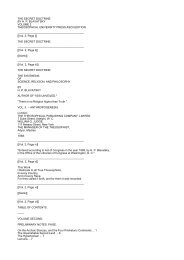Create successful ePaper yourself
Turn your PDF publications into a flip-book with our unique Google optimized e-Paper software.
The Versions Of The <strong>Book</strong> Of The <strong>Dead</strong>.<br />
Sacred Texts Egypt Index Previous Next<br />
INTRODUCTION.<br />
THE VERSIONS OF THE BOOK OF THE DEAD.<br />
The four great Versions <strong>of</strong> <strong>the</strong> <strong>Book</strong> <strong>of</strong> <strong>the</strong> <strong>Dead</strong>.<br />
THE history <strong>of</strong> <strong>the</strong> great body <strong>of</strong> religious compositions which form <strong>the</strong> <strong>Book</strong> <strong>of</strong> <strong>Dead</strong> <strong>of</strong> <strong>the</strong> ancient<br />
Egyptians may conveniently be divided into four[1] <strong>of</strong> <strong>the</strong> periods, which are represented by four<br />
versions:--<br />
1. The version which was edited by <strong>the</strong> priests <strong>of</strong> <strong>the</strong> college <strong>of</strong> Annu (<strong>the</strong> On <strong>of</strong> <strong>the</strong> Bible, and <strong>the</strong><br />
Heliopolis <strong>of</strong> <strong>the</strong> Greeks), and which was based upon a series <strong>of</strong> texts now lost, but which <strong>the</strong>re is<br />
evidence to prove had passed through a series <strong>of</strong> revisions or editions as early as <strong>the</strong> period <strong>of</strong> <strong>the</strong> Vth<br />
dynasty. This version was, so far as we know, always written in hieroglyphics, and may be called <strong>the</strong><br />
Heliopolitan version. It is known from five copies which are inscribed upon <strong>the</strong> walls <strong>of</strong> <strong>the</strong> chambers<br />
and passages in <strong>the</strong> pyramids[2] <strong>of</strong> kings <strong>of</strong> <strong>the</strong> Vth and VIth dynasties at Sakkâra;[3] and sections <strong>of</strong> it<br />
are found inscribed upon tombs, sarcophagi, c<strong>of</strong>fins, stelæ and papyri from <strong>the</strong> XIth dynasty to about<br />
A.D. 200.[4]<br />
[1. See Naville, Todtenbuch (Einleitung), p. 39.<br />
2. Hence known as <strong>the</strong> "pyramid texts."<br />
3. I.e., Unâs, Tetâ, Pepi I., Mentu-em-sa-f, and Pepi II. Their pyramids were cleared out by MM. Mariette and Maspero<br />
during <strong>the</strong> years 1890-84, and <strong>the</strong> hieroglyphic texts were published, with a French translation, in Recueil de Travaux, t.<br />
iii-xiv., Paris, 1882-93.<br />
4. In <strong>the</strong> XIth, XIIth, and XIIIth dynasties many monuments are inscribed with sections <strong>of</strong> <strong>the</strong> Unâs text. Thus lines 206-69<br />
are found in hieroglyphics upon <strong>the</strong> c<strong>of</strong>fin <strong>of</strong> Amamu (British Museum, No. 6654. See Birch, Egyptian Texts <strong>of</strong> <strong>the</strong><br />
Earliest Period from <strong>the</strong> C<strong>of</strong>fin <strong>of</strong> Amamu, 1886. Plates XVII.-XX.); Il. 206-14 and 268-84 on <strong>the</strong> c<strong>of</strong>fin <strong>of</strong> Apa-ankh,<br />
from Sakkâra (see Lepsius, Denkmäler, ii., Bl. 99 b; Maspero, Recueil, t. iii., pp. 200 and 214 ff.); Il. 206-10 {footnote<br />
page x.} and 268-89 on <strong>the</strong> c<strong>of</strong>fin <strong>of</strong> Antef (see Lepsius, Denkmäler, ii., Bl. 145; Maspero, Recueil, t. iii., pp. 200, 214);<br />
line 206 on a c<strong>of</strong>fin <strong>of</strong> Menthu-hetep at Berlin (see Lepsius, Aelteste Texte, Bl. 5); lines 269-94 on <strong>the</strong> sarcophagus <strong>of</strong><br />
Heru-hetep (see Maspero, Mémoires, t, i., p. 144). A section is found on <strong>the</strong> walls <strong>of</strong> <strong>the</strong> tomb <strong>of</strong> Queen Neferu (see<br />
Maspero, Recueil, t. iii., p. 201 ff.; Mémoires, t. i., p. 134); o<strong>the</strong>r sections are found on <strong>the</strong> sarcophagus <strong>of</strong> Taka (see<br />
Lepsius, Denkmäler, ii., Bll. 147, 148; Maspero, Guide au Visiteur, p. 224, No. 1053; Mémoires, t. i., p. 134); lines 5-8<br />
occur on <strong>the</strong> stele <strong>of</strong> Apa (see Ledrain, Monuments Égyptiens de la Bibl. Nationale, Paris, 1879, foll. 14, 15); lines 166 ff.<br />
are found on <strong>the</strong> stele <strong>of</strong> Nehi (see Mariette, Notice des Mon. à Boulaq, p. 190; Maspero, Recueil, t. iii., p. 195); and lines<br />
576-83 on <strong>the</strong> c<strong>of</strong>fin <strong>of</strong> Sebek-Aa (see Lepsius, Aelteste Texte, Bl. 37; Maspero, Recueil, t. iv., p. 68). In <strong>the</strong> XVIIIth<br />
dynasty line 169 was copied on a wall in <strong>the</strong> temple <strong>of</strong> Hatshepset at Dêr el-baharî (see Dümichen, Hist. Inschriften, Bll.<br />
25-37; Maspero, Recueil, t. i., p. 195 ff.); and copies <strong>of</strong> lines 379-99 occur in <strong>the</strong> papyri <strong>of</strong> Mut-hetep (British Museum,<br />
No. 10,010) and Nefer-uten-f (Paris, No. 3092, See Naville, Todtenbuch, Bd. I., Bl. 197; Aeg. Zeitschrift, Bd. XXXII., p. 3;<br />
and Naville, Einleitung, pp. 39, 97). In <strong>the</strong> XXVIth dynasty we find texts <strong>of</strong> <strong>the</strong> Vth dynasty repeated on <strong>the</strong> walls <strong>of</strong> <strong>the</strong><br />
tomb <strong>of</strong> Peta-Amen-apt, <strong>the</strong> chief kher-heb at Thebes (see Dümichen, Der Grabpalast des Patuamenap in der<br />
Thebanischen Nekropolis, Leipzig, 1884-85); and also upon <strong>the</strong> papyrus written for <strong>the</strong> lady Sais ###, about A.D. 200 (see<br />
Devéria, Catalogue des MSS. Égyptiens, Paris, 1874, p. 170 No. 3155). Signor Schiaparelli's words are:--"Esso è scritto in<br />
ieratico, di un tipo paleografico speciale: l' enorme abbondanza di segni espletivi, la frequenza di segni o quasi demotici o<br />
quasi geroglifici, la sottigliezza di tutti, e l'incertezza con cui sono tracciati, che rivela una mano più abituata a scrivere in<br />
http://www.sacred-texts.com/egy/ebod/ebod03.htm (1 <strong>of</strong> 36) [8/10/2001 11:22:54 AM]

















